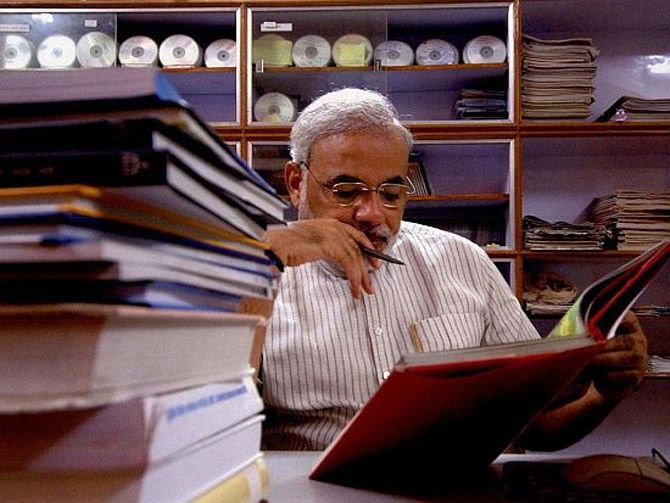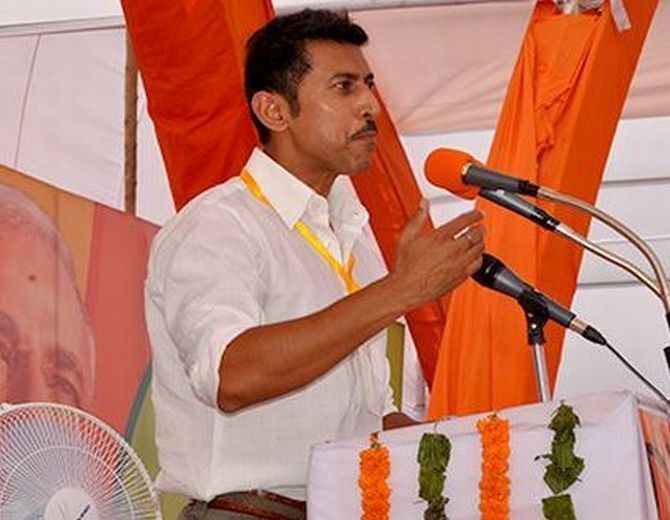 | « Back to article | Print this article |

Three months after the current govt effected the first Cabinet expansion, Nivedita Mookerji & Sanjeeb Mukherjee takes a look at how busy the junior ministers are in NDA regime
Several junior ministers in the United Progressive Alliance government, including Jyotiraditya Scindia, Saugata Ray and Pratik Patil, had in 2010 complained to Manmohan Singh, then prime minister, that they were not getting enough work.
Singh had advised Cabinet ministers to allocate meaningful work to their junior colleagues but little was done about it. Four years later, when a Narendra Modi-led National Democratic Alliance government took charge at the Centre, there were indications of a more equal relationship among the senior and junior ministers.
About three months after the current government effected the first expansion of its council of ministers -- to a total of 26 ministers of state, 13 ministers of state with independent charge, and 27 ministers in the Cabinet rank (with the PM) -- Business Standard took a look at how busy the junior ministers were in the NDA regime.
MoS for Finance Jayant Sinha and MoS for Information and Broadcasting Rajyavardhan Singh Rathore are seen as the most prominent and proactive junior ministers.
Similarly, ministers of state like Sanjeev Kumar Balyan (agriculture), Mukhtar Abbas Naqvi (minority affairs), Hansraj Gangaram Ahir (chemicals and fertiliser) hold their own in ministerial work, or even in resolving political issues.
A finance ministry official says Sinha attends all important meetings, including those on the Union Budget; speaks on public platforms; and actively participates in major decisions.
Earlier, it was never so, he says. “It was rare to hear UPA MoSes for finance, S S Palanimanickam or Namo Narain Meena, speaking.”
Many believe this has much to do with Union Finance and I&B Minister Arun Jaitley, whose involvement in the Bharatiya Janata Party's political work is deep. While Prime Minister Modi trusts his word on most matters, Jaitley is also known to encourage junior colleagues.
Sinha, a Harvard alumnus, recently told the global investor community a simple and predictable tax regime was in the works. India's tax and regulatory regime would be the best in the world, he said, and assured that Mumbai would be developed as an international financial services centre. This sent out a positive signal to investors globally.
In the I&B ministry, Rathore, an Olympic medallist for shooting, too, is believed to be free to take decisions.
“He is fully involved and all files go through Rathore,” says a ministry official.
Among other issues, Rathore was recently seen at the forefront in tackling the controversy over a Republic Day advertisement that had omitted the words ‘socialist’ and ‘secular’ from the preamble.
 The junior I&B minister even tweeted pictures of the original preamble of the Constitution, showing it without those two words. Before that, he was busy denying allegations of interference and corruption that the then Censor Board chairperson Leela Samson had levelled.
The junior I&B minister even tweeted pictures of the original preamble of the Constitution, showing it without those two words. Before that, he was busy denying allegations of interference and corruption that the then Censor Board chairperson Leela Samson had levelled.
In spite of active participation by some junior ministers in the current government, a civil servant argues that volume of work for them has gone up but not the weight of the work they do. All budgetary decisions are still taken by a Cabinet minister or MoS with independent charge, he says.
Junior ministers are not empowered to handle the “real meat”, including clearing foreign trips of officials, he adds. “Even in the Modi government, most junior ministers are busy replying to unstarred Parliament questions, attending not so important meetings, and inaugurating events.”
However, the official word coming out of the government is that all senior ministers have stipulated that work flow be routed through junior ministers. Another directive to all ministers, senior and junior, is that they must use social media proactively, to send the positive message across.
So, most junior ministers tweet at any given opportunity. Babul Supriya, a popular playback singer who is now a MoS for urban development and housing, tweeted last week: “Both didi (Mamata Banerjee) & Arvind Kejriwal are anti-reformist-populists. To them, logic or economics don't exist. Hoping Delhi won't repeat its mistake.”
Even as the celebrity-turned-minister has hardly been seen talking of smart cities or housing for all, focus areas of the Modi government for this ministry, Supriya was roped in to woo Bengali voters during Saturday's Delhi assembly election.
Some ministries have more than one MoS, even as work allocation might not be equal.
Sanjeev Kumar Balyan and Mohanbhai Kalyanjibhai Kundariya are the two junior ministers for agriculture, under Radha Mohan Singh. Balyan, appointed in June 2014, is seen as more active than Kundariya, who was inducted in the November expansion. Balyan's background of one from western Uttar Pradesh, an agricultural belt, might have helped.
Officials say a big programme of the agriculture ministry -- the National Mission To Develop Indigenous Varieties of Cattle (also known as 'Gokul Mission') -- is being run under Balyan's direct supervision. He even participated in a meeting called by Food Minister Ram Vilas Paswan recently, to sort out the sugar crisis in the region.
Talking of Paswan, his junior minister in the food and consumer affairs ministry, Raosaheb Dadarao Danve, usually handles matters related to the consumer affairs part of the department. Danve has been subdued, with most of the talking being done by Paswan himself. But in a critical matter related to the sugar industry, Danve put forward his views, which were marginally different from the position being taken until then. Recently, he was appointed BJP's Maharashtra state president, and there was a speculation Danve might vacate his MoS job.
The ministry of rural development is another with multiple MoSes. Nihal Chand, Ram Kripal Yadav and Sudarshan Bhagat are the three ministers of state under Chaudhary Birender Singh. In fact, the ministry has seen three Cabinet ministers in the past nine months and an equal number of MoSes.
 Earlier, Upendra Kushwaha had taken charge as MoS under Gopinath Munde, who died last year. While Kushwaha was shifted to the human resource development ministry under Smriti Irani, the current ministers for rural development took office in November.
Earlier, Upendra Kushwaha had taken charge as MoS under Gopinath Munde, who died last year. While Kushwaha was shifted to the human resource development ministry under Smriti Irani, the current ministers for rural development took office in November.
Then, there are others like Mukhtar Abbas Naqvi, MoS for minority affairs under Najma Heptullah. Naqvi, well known in political circuits, was recently in news for receiving, along with actor Shah Rukh Khan and others, 'ghar wapsi' invitation from the Hindu Mahasabha. Naqvi was also among the BJP ministers who held rallies in the run-up to the Delhi Assembly election.
Haribhai Parthibhai, the 60-year-old MoS for home affairs under Rajnath Singh, is an active member of the Rashtriya Swayamsevak Sangh.
Parthibhai, who earlier held several key positions in the party's Gujarat unit, is seen as an important junior minister. With another MoS, Kiren Rijiju, already there in the ministry, Parthibhai, a close Modi aide, has been made incharge of internal security, police modernisation, Centre-state and UnionTerritory divisions.
Among others with political weight and perhaps some work load is Sanwar Lal Jat, a close confidant of Rajasthan Chief Minister Vasundhara Raje. He is MoS for water resources, river development and Ganga Rejuvenation under Uma Bharti. Jat's claim to fame also lies in the fact that he defeated Sachin Pilot in the Lok Sabha election in the Ajmer constituency.
Chemicals and Fertiliser MoS Ahir, is weighty, too -- more so after former Lok Sabha speaker Somnath Chatterjee complimented him for his “excellent” performance as a MP.
Ahir is reported to be among the people who exposed the coal scam. A contrast, though, could be someone like Sadhvi Niranjan Jyoti, MoS for food processing, who is known more for her hate speeches than anything related to her ministry.